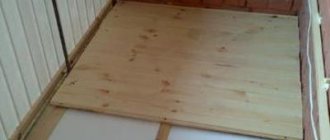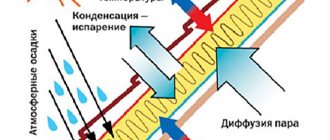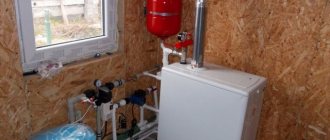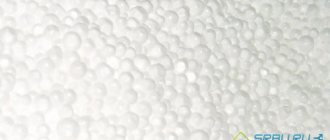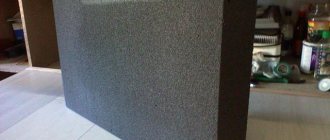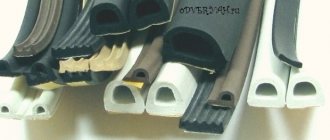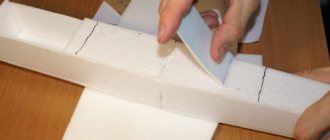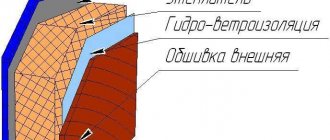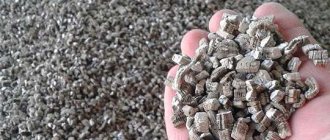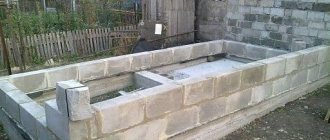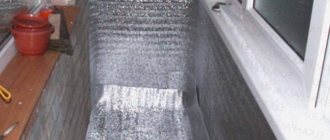Composition and production of ecowool
Ecowool is produced mainly from waste from the paper industry. Waste paper is used less frequently, but in this case the quality level is somewhat reduced. The production technology was borrowed from Finland.
The cellulose part of ecowool is about 80%, the rest is chemicals that impart stickiness when moistened (lignin), retard combustion (boric acid) and have antiseptic properties (borax). These components are used in domestic production. American manufacturers prefer ammonium phosphates and sulfates, which release toxic substances into the air in large quantities.
Methods of applying ecowool
There are three options for applying ecowool: manual, automatic dry and automatic wet.
The first is used mainly for filling horizontal voids. Most often these are floors and attic floors. For this purpose, the mixture is loosened in any suitable container, and then, manually, placed in the desired place.
This method is only suitable for small spaces, as it is quite labor-intensive and time-consuming.
The dry automatic method of applying ecowool is used to fill vertical, horizontal and inclined cavities. These are walls, ceilings, floors and roofs.
For automated application of ecowool, special installations are used. The principle of their operation is based on whipping the filler in a special hopper, and then blowing out the components with a stream of air.
In this way it is convenient to fill existing voids in the finished structure.
The wet automatic method is used to apply insulation to open areas. It differs from the dry method in that the blown mass is pre-mixed with water or glue. To do this, a special nozzle and a device for uniform supply of water or glue are added to the above-described unit.
Construction of houses
181 votes
+
Vote for!
—
Vote against!
Due to the inevitable deterioration of the environmental situation on the planet, both beginners and experienced craftsmen, when choosing thermal insulation materials, began to pay attention to products characterized not only by a high level of heat and sound insulation, as well as ease of installation, but also made from natural environmentally friendly materials. The possibility of self-installation is also valued by consumers, since in this case they get the opportunity to fully control each stage of applying the material, which will not only save money, but also, in case of any damage, fix it themselves. One of these materials is ecowool, which, despite the above characteristics, has not yet received due popularity, which leads to the fact that consumers often prefer foam plastic, already tested and tested by many builders, as well as mineral wool. We are confident that after reading this article, you will be convinced of the undeniable advantages of ecowool, as well as the simplicity of its application technique, which we will also talk about in this material.
Content
- Ecowool: structural composition and feasibility of use
- Main advantages of ecowool
- Disadvantages of ecowool: what did you not know about the material?
- Ecowool application methods: manual and automated
- Equipment for the automated method of applying ecowool
- How to insulate with ecowool: basic application methods
- Dry method of applying ecowool
- Wet installation method of ecowool
- Wet-adhesive method of applying ecowool
- Recommendations from experts on how to apply ecowool yourself
Ecowool: structural composition and feasibility of use
The lack of popularity of ecowool, associated with its recent appearance on the construction market, as well as the long absence of the necessary equipment for its application, is a completely fixable matter, since its undeniable advantages cannot go unnoticed. Thermal insulation material ecowool is characterized by a loose structure, 80% consisting of cellulose, which has the highest thermal insulation properties and excellent mechanical characteristics, due to which, after its application, a homogeneous layer is formed, devoid of seams and irregularities. But, despite its characteristics, cellulose is not used in construction work in its pure form, due to its high flammability. In the composition of ecowool, these properties of cellulose do not prevent its use, since in addition to cellulose, its structure includes a fire retardant, which is borax, and an antiseptic, boric acid. The use of these components in the structure of ecowool makes it absolutely fireproof and can be used for thermal insulation of boilers and chimneys. The use of boric acid helps prevent damage to the thermal insulation layer by rodents and insects, as well as the appearance of mold and mildew.
Important! Unlike ecowool, mineral wool does not contain boric acid, and therefore it is often damaged by rodents and insects.
Main advantages of ecowool
- Despite the fact that ecowool is practically unable to transmit wet steam and heat, it easily absorbs large amounts of moisture, and unlike mineral wool, this does not affect its thermal conductivity in any way. The thermal conductivity of the previous one, when the humidity level increases by at least 1%, increases accordingly by 8-9%. In this regard, you get the opportunity to use ecowool for insulation of wooden frame houses, where it will help maintain an optimal level of humidity;
- Due to the fact that ecowool is a homogeneous loose mass, if all the rules for its application are followed, a seamless layer with high thermal insulation characteristics is formed, while the formation of voids and cold bridges, which contribute to a decrease in thermal insulation characteristics, is completely eliminated;
- Ecowool, in comparison with mineral wool, has higher sound insulation characteristics and, unlike foam plastic, has higher elasticity, which also allows it to more effectively dampen any external sounds;
- Ecowool contains no substances harmful to human health. Absolutely safe lignin is used as an adhesive, while the antiseptic and fire retardant, which do not spray or evaporate, also do not pose any harm, which cannot be said about the commonly used polystyrene foam;
- Ecowool is a bulk material that, in the case of industrial installation, is pre-moistened. The material can be used without preliminary moistening; then ecowool is pumped into the frame using a compressor. Laying ecowool can also be done manually, which is the most labor-intensive and time-consuming method of application.
- Low chemical activity, due to which corrosion processes do not form at the points of contact between the heat-insulating coating and metal parts of fasteners or the building frame;
Important! Due to the random arrangement of cellulose fibers included in the ecowool structure, it eliminates shrinkage of the material in the case of vertical application. This contributes to the long-term preservation of the thermal insulation properties of the coating.
Disadvantages of ecowool: what did you not know about the material?
- Despite the fact that ecowool is an absolutely non-flammable material, it can smolder when exposed to high temperatures. In this regard, when insulating objects subject to heating, basalt or asbestos is additionally used;
- Application of ecowool is a process, the complexity of which depends on the method of its installation. To carry out installation activities correctly, sufficient experience and the use of specialized equipment will be required;
- During the process of insulation with ecowool, a large number of dust microparticles of cellulose and borax are formed;
- In the case of wet application of ecowool, subsequent installation activities can be carried out no earlier than a day later;
- And, perhaps, one of the most important disadvantages is the fairly high cost of ecowool insulation, which is several times higher than thermal insulation using traditional polystyrene foam and mineral wool.
Ecowool application methods: manual and automated
Installation of ecowool can be carried out in several ways, each of which is intended to achieve different purposes and is characterized by its own advantages and disadvantages. One of the simplest ways to insulate ceilings and floors is to manually apply ecowool. Despite the fact that this method is characterized by a number of advantages, there is a more modern - semi-automated method, which involves applying the material using a sprayer.
The manual method involves performing the work in stages, the first of which consists of pouring the required mass of insulation into a container of a certain volume. You can use bulk boxes or a bucket as this container. Taking into account the fact that ecowool is supplied to the retail network in compressed form, the next stage of work consists of “fluffing” the material. To do this, you will need a drill or a specialized attachment for mixing paints and varnishes. It must be remembered that after this activity is completed, the volume of material will increase at least three times. Having carried out the above steps, experts recommend proceeding with the direct installation of ecowool, which involves filling it into vertically oriented structures or floor coverings. In the process of manual laying, it is important to know the packing density of the material for each insulated element, which is, first of all, determined by the material consumption. So, for example, in the case of insulating floors, the optimal density of insulation is 35-50 kg per cubic meter. In the case of wall insulation, the required material consumption is 60 kg per cubic meter, and for roof insulation - 50 kg per cubic meter.
Important! If you need to insulate houses with a large area or cottages, the manual method of installing ecowool is unsuitable for this, since in this case you will have to resort to the use of specialized blowing equipment.
Equipment for the automated method of applying ecowool
To install ecowool using an automated method, you will need the following equipment for applying ecowool:
- An automatic blowing installation equipped with a specialized agitator, with the help of which you can produce a more uniform supply of heat-insulating material to the place of its direct installation;
- Corrugated hoses, which will be used to supply insulation to the work site;
- Water-adhesive installation of ecowool involves the use of a set of specialized foams;
- Wet spraying is carried out using an additional kit;
- A more modern version of specialized equipment involves additional equipment with blowing nozzles and electric trimming rollers, which will be required to remove excess material.
How to insulate with ecowool: basic application methods
Answering the question: “How to insulate using ecowool?”, we consider it necessary to consider all the main methods of insulation using this thermal insulation material. If we talk about applying ecowool using specialized equipment, it is necessary to consider three installation methods, such as dry, wet and wet-adhesive installation of ecowool, each of which will be discussed in detail below.
Dry method of applying ecowool
This method is especially relevant in the case of cellulose insulation of horizontal and inclined surfaces, as well as for carrying out installation activities in interfloor ceilings, and filling voids that represent closed spaces in the walls.
Installation of ecowool using the dry method looks like this:
The initial stage involves the organization of holes in confined spaces limited by membrane waterproofing, which will subsequently be filled with insulation. It is important to remember that the diameter of these holes must completely coincide with the diameter of the corrugated hose or spray nozzle, with the help of which the automated installation of the heat-insulating layer will be carried out. Subsequently, the newly installed hole is connected to a hose, which facilitates the flow of ecowool mixed with air to the place of its installation. The presence of air in the composition of the heat insulator contributes to its more efficient delivery to its destination, as well as to the maximum filling of the free space with ecowool particles with the subsequent formation of a durable cellulose plug. Free cavities are filled until they are filled with the required insulation density.
Applying insulation to surfaces located in a horizontal plane is done in a similar way, however, the only difference is that before applying ecowool there is no need to arrange preliminary insulation.
Wet installation method of ecowool
If you need to insulate vertical planes characterized by free access, wet application of ecowool will be the most optimal way to carry out thermal insulation measures. The fundamental difference of this method is that ecowool, pre-moistened with water, is applied to open surfaces that are freely accessible and limited by frame structures. Ecowool is moistened with the aim of maximizing the filling of the free space with insulation, which, due to the inclusion of lignin in the ecowool structure, which acquires stickiness upon contact with water, adheres tightly to the frame. If, after applying ecowool, you notice excess material clearly protruding above the frame, you need to resort to using an electric trimming roller, with which you can remove excess cellulose material.
Wet-adhesive method of applying ecowool
This method is in many ways similar to the previous one, but is characterized by one distinctive point, the essence of which is the addition of an adhesive substance to the structure of the heat-insulating mixture, which gives it a number of undeniable advantages. The most outstanding of them are the following advantages:
- Low probability of deformation of the cellulose material after it dries;
- Higher level of elasticity of the thermal insulation material;
- No harmful impurities in the material.
Applying ecowool using this method is most relevant in the case when it is necessary to insulate surfaces located in a horizontal plane and characterized by a lack of free access to their lower part. Typical examples of such structures are ceilings, structures located in a suspended position, as well as other thin-walled structures.
In the process of implementing thermal insulation by applying ecowool with your own hands, you can solve several installation and technological problems at once:
- Implementation of high-quality sound insulation;
- At the same time, you solve the problem of condensation in a room insulated with ecowool;
Recommendations from experts on how to apply ecowool yourself
- In order to correctly calculate the required number of ecowool packages, the weight of which is 15 kg, you can use online calculators on any construction site or make the necessary calculations yourself. To do this, it is necessary to multiply the area of the insulated surface by the technological consumption of material presented in our article;
- Experts recommend being guided by the following parameters. The recommended insulation thickness for the floor is 15-20 cm, for a pitched roof - 15-20 cm, for interfloor floors this parameter is 10-15 cm, for attic floors - 20-30 cm;
- When purchasing ecowool, do not forget that the consumption of thermal insulation material may exceed the calculated values by 10%, and therefore it is important to purchase material with a reserve;
- Initially, the characteristics of ecowool are such that it is intended for insulating wooden structures. In this case, it is applied directly to the surface, without the use of insulating materials. In the case of insulating surfaces made of metal, brick and concrete, before directly applying the insulation, it is necessary to “isolate” the ecowool from the surface being treated using an insulating material. This will prevent the formation of condensation in the room;
- During the installation of ecowool, it is important to take into account possible shrinkage of the material under the pressure of its own weight. This most often occurs in the case of insulation of high vertical cavities. To prevent this, horizontally oriented dividing partitions are installed in the insulated cavities during the installation of insulation, which help reduce the initial weight of the insulation;
- In case of roof insulation, it is also necessary to take measures to prevent the formation of sub-roof condensation.
Advantages of ecowool
Ecowool, as insulation, has a number of positive qualities. Namely:
- Resistant to combustion. Ecowool belongs to the class of slightly flammable materials, is characterized by a low degree of smoke formation, and does not emit hazardous substances when ignited;
- Environmentally friendly. Cellulose wool is made from natural ingredients, therefore it does not emit harmful fumes into the air and does not pose a danger to human health;
— Safety against fungus and insects. Thanks to boric acid and its salts, which are part of ecowool, the insecticidal and antiseptic properties of the insulation are ensured;
— High sound insulation. In terms of sound absorption, cellulose wool surpasses all similar materials;
— Low thermal conductivity. A layer of ecowool about 15 cm thick corresponds, in terms of thermal conductivity, to brickwork, 4 bricks thick;
— Vapor permeability;
— Ease of application. To insulate a room with ecowool, there is no need to completely dismantle any structures. It is enough to make a hatch of the required size;
— Affordability;
— Absence of joints and seams when applied to the surface;
Technology of self-insulation with ecowool
The process of blowing walls with ecowool can be entrusted to companies specializing in this type of insulation. Experienced craftsmen using professional equipment will quickly and efficiently insulate your home. But it should be borne in mind that such work has a fairly high cost.
In order to save money, the process of laying cellulose material can be done with your own hands using available tools.
Tools and materials
To apply ecowool on walls yourself, you need to select the following set of materials and tools:
- beams for the frame base;
- cellulose insulation;
- garden vacuum cleaner with a power of at least 2000 watts;
- corrugated hose with a diameter of at least 7 millimeters;
- wide construction tape;
- drill with stirring attachment;
- material preparation capacity;
- roller trimming knife.
If blowing with a layer of more than 7 centimeters is planned, then a windproofing film coating will also be required.
Wall insulated with ecowool
